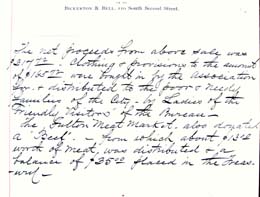This People's History is based on the early records of Wellspring Family Services, a private, non-profit organization helping families and children in Seattle and King County overcome life’s challenges. Founded in 1892 as the Bureau of Associated Charities, Wellspring Family Services has operated under a succession of names. This essay documents the organization's first fundraising attempt, an auction, held on December 22, 1893. The organization's services have changed over the years, but have always centered on a commitment to a stronger, healthier community. These archival records offer glimpses into aspects of Seattle history not well documented elsewhere, examining societal attitudes toward poverty, need, illness, and addiction -- all of which have altered considerably since Wellspring's early days. This is one of a series entitled "Out of the Archives," and appeared in April 2011 in Wellspring's monthly internal newsletter, The Fiddlehead. It was written by Wellspring Family Services executive assistant Deborah Townsend.
Our First Fundraiser
The nationwide Panic of 1893 began when a long build-up of economic speculation and over-extension began to collapse. The apparent but unsupported growth had been especially dramatic in railways, mining, and banking, and many rail and mining interests sustained their growth by taking over their competitors -- with money borrowed from the banks. It couldn’t last. Early 1893 saw a series of railroad bankruptcies, including two major lines in Washington state: the Northern Pacific Railroad and the Union Pacific Railway. By the end of 1893, more than 500 banks had failed nationwide, destroying the life savings of many families (this was long before any kind of deposit insurance). Unemployment reached close to 20 percent. On top of all the other woes, the Midwest had suffered a series of drought years. Many debt-burdened farmers abandoned their land and headed for the cities, especially in the West.
Against this background of economic disaster and overwhelming need, the recently-founded Bureau of Associated Charities of Seattle was struggling to survive and provide relief for the homeless, hungry, and destitute all around it in its community.
In 1893, the Executive Committee of the Board of Directors met once a week to oversee the work of the Bureau. The committee routinely received reports about applications for aid, relief authorized and given, and contributions received. Board members, as today, discussed potential fundraising enterprises. The notes of December 11, 1893, state:
"Mr. Bickerton of the auction firm of Bickerton & Bell called and presented for the approval of the Committee a scheme for a grand ‘Charity Auction,’ the proceeds to be donated to the Bureau of Associated Charities, without expense [i.e. no fee to the auction house]. His plan was accepted and he was authorized to carry it out in the interest of the Bureau."
Two pages later we see a copy of the event announcement pasted into the Executive Committee minutes book. (Committee meeting notes were written in the book by hand, with other items such as newspaper clippings pasted in here and there, scrapbook-style.)
The announcement is a simple half-sized sheet, 5 ½ x 8 ½ inches, black-and-white, nothing fancy. Remember that the concept of "desktop publishing" is still 80 or so years in the future! This handbill would have been produced in a print shop, as quickly and inexpensively as possible, so as to get the word out in time -- the auction was planned for December 22, a mere 11 days after the Executive Committee gave Mr. Bickerton the go-ahead.
The announcement gives the reason for the auction ("Considering the present depressed state of the times, and that many of our fellow citizens are out of employment and in urgent need ...") and explains how it will work. The proposed logistics tell us clearly that Seattle’s business community was still small and close-knit at the time. The flier puts all Seattle on notice that someone -- we don’t know who, possibly Board members or volunteer Friendly Visitors from the Bureau, possibly volunteers from the auction house -- will visit everyone in the business community, in person, on Wednesday, December 20, with the clear expectation that every business will donate "something, no matter how small" (note the emphasis!) to be auctioned off to support the Bureau’s work. Nowadays a charity benefit auction takes months and months to organize. These folks did it in just 11 days, collecting all the donations in the two days before the event.
And the results? Here is the summary from the Executive Committee book:
"The net proceeds from above sale was $317.72. Clothing & provisions to the amount of $165.72 were brought in by the Association for & distributed to the poor & needy families of the City by Ladies of the 'Friendly Visitors' of the Bureau. The Fulton Meat Market also donated a 'Beef' from which about $13.00 worth of meat was distributed & a balance of $35.00 placed in the Treasury."
Our case records of the time include notes like "gave $2.50 for groceries" and "rent is $8/mo" so we know that the Bureau stretched that $317.72 to help a lot of families.
The auction house address is given as "110 South Second Street" (we call it 2nd Avenue now) at the corner of 2nd Avenue and Yesler Way. In 1893, the agency offices were in the Seattle National Bank Building, also at 2nd Avenue and Yesler Way -- just a few blocks from where our agency had its administrative offices in Pioneer Square in later years, in the Lowman Building 1979-1992 and the Broderick Building 1992-2009.

